Abstract
Peptides with transmitter-like characteristics are being found in many brain areas. The application of immunocytochemical and radioimmunoassay methods has contributed much to the clarification of these neuronal systems. Here we report the development of a rat monoclonal antibody produced by a hybrid myeloma and its application to the study of one of these peptides, substance P. The hybrid clone, isolated after fusion of mouse myeloma cells with hyperimmune rat spleen cells, allowed us to obtain a standardized and permanent source of monoclonal substance P antibodies in a culture cell system. This antibody recognizes the COOH-terminal part of substance P in radioimmunoassay down to 10-20 fmol. It does not crossreact with other known mammalian brain peptides tested. By immunofluorescence the antibody was shown to bind specifically and with a remarkably low background to nerve terminals and cell bodies located in clearly defined nuclear organizations of the central nervous system.
Full text
PDF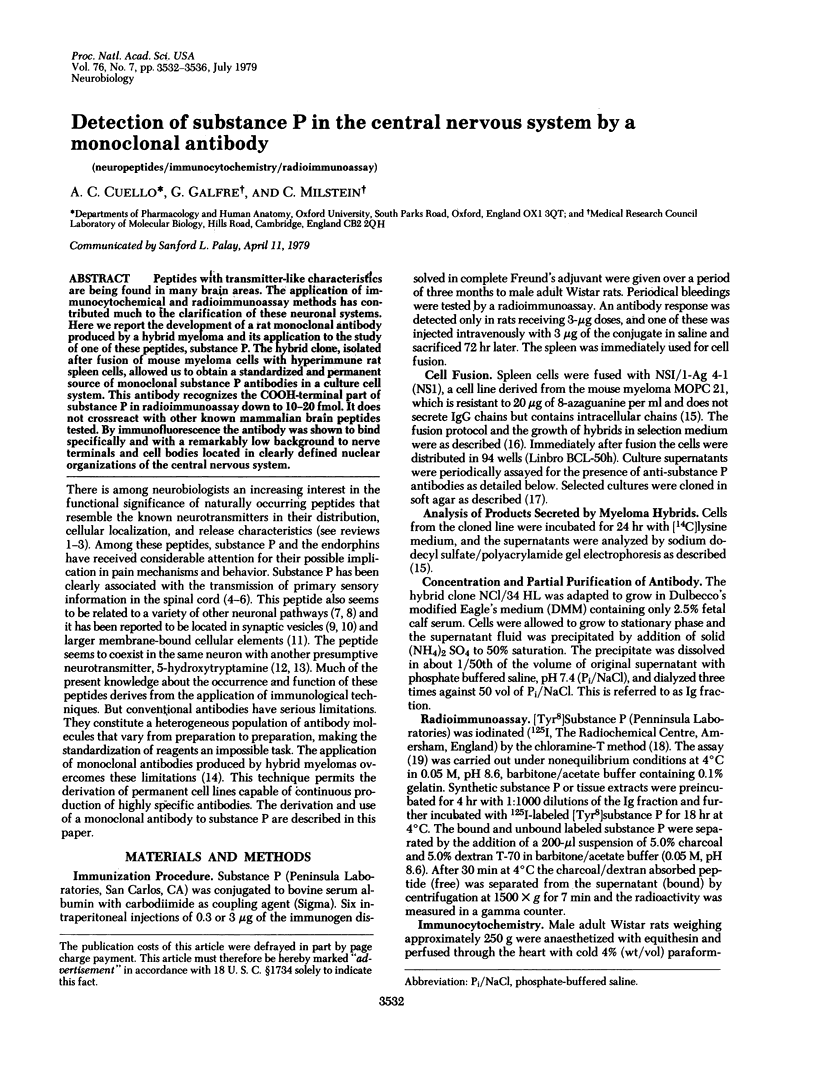
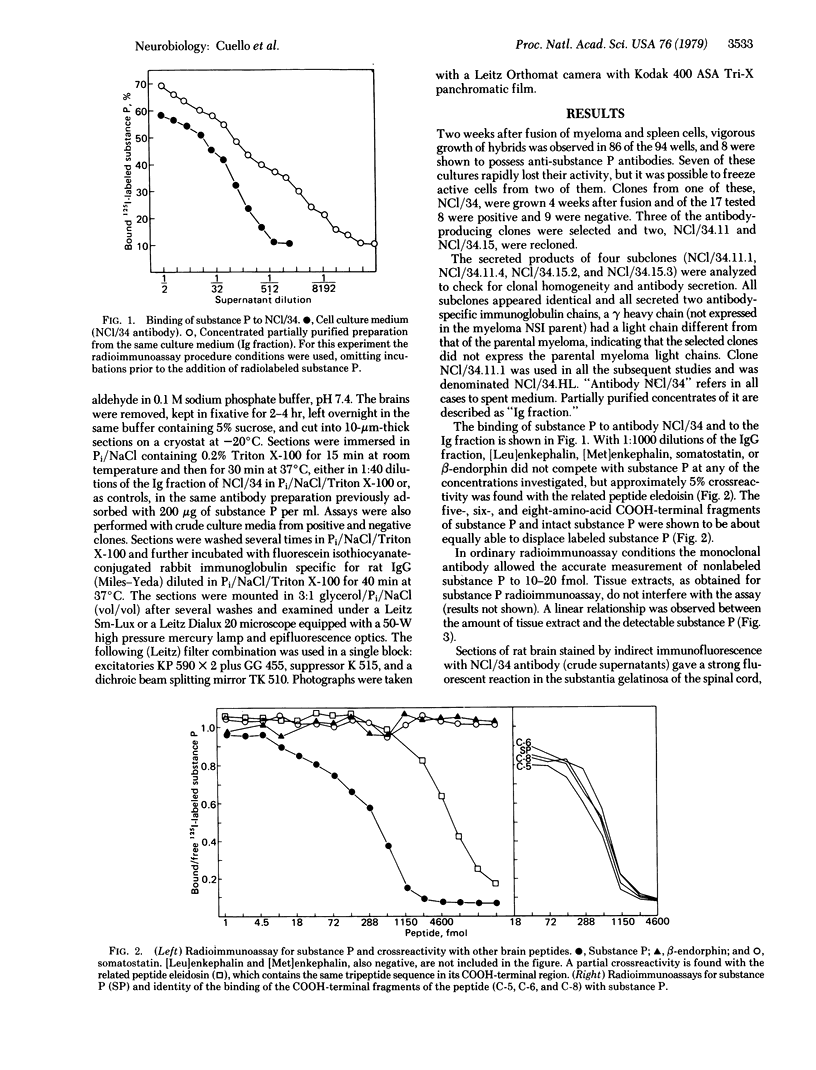
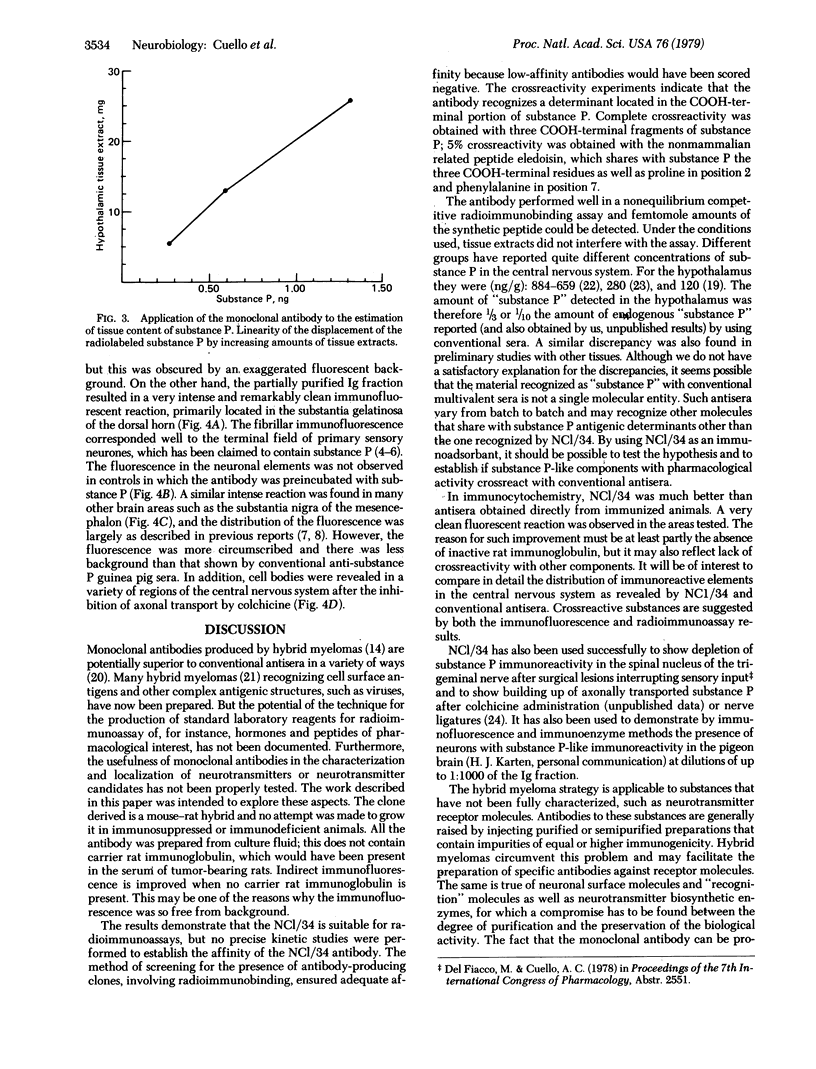
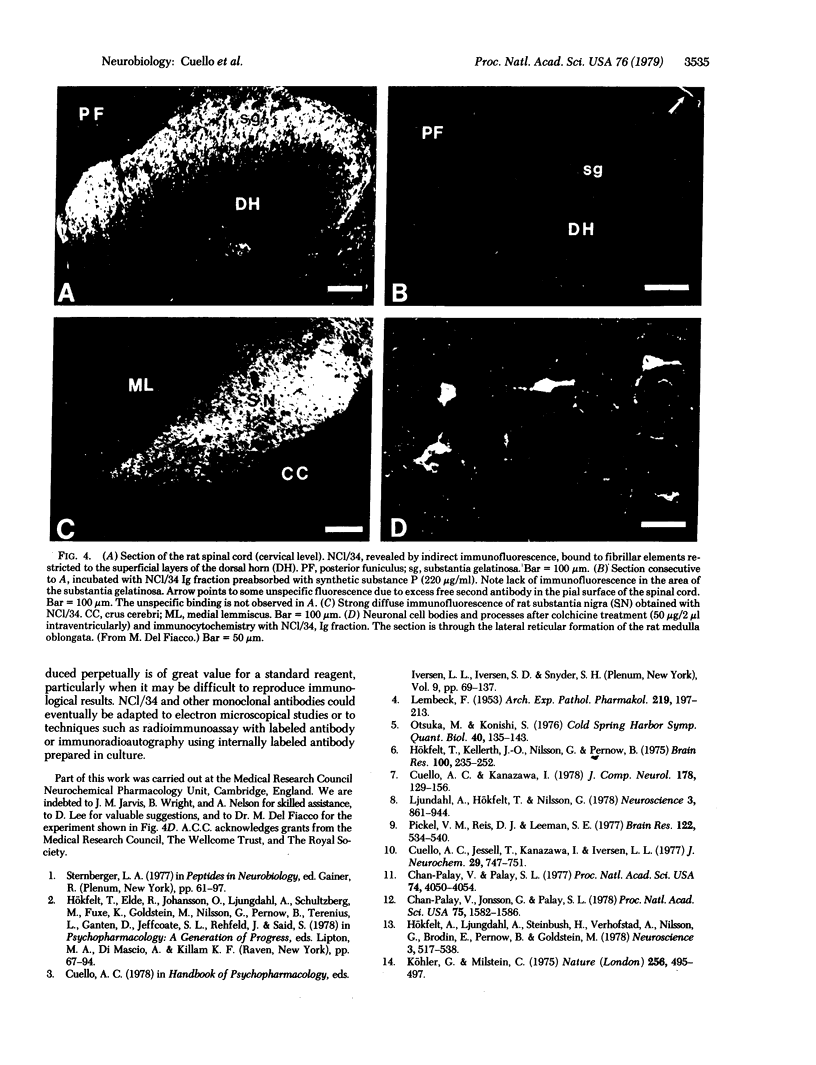
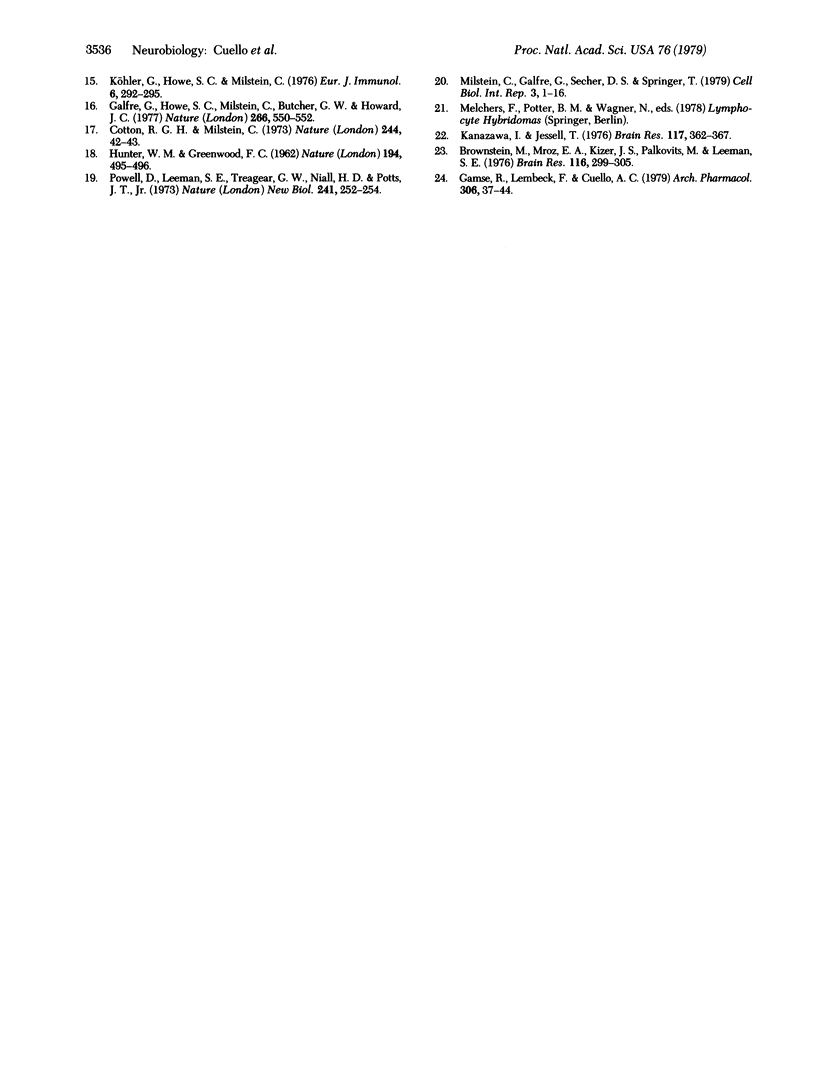
Images in this article
Selected References
These references are in PubMed. This may not be the complete list of references from this article.
- Brownstein M. J., Mroz E. A., Kizer J. S., Palkovits M., Leeman S. E. Regional distribution of substance P in the brain of the rat. Brain Res. 1976 Nov 5;116(2):299–305. doi: 10.1016/0006-8993(76)90907-0. [DOI] [PubMed] [Google Scholar]
- Chan-Palay V., Jonsson G., Palay S. L. Serotonin and substance P coexist i, neurons of the rat's central nervous system. Proc Natl Acad Sci U S A. 1978 Mar;75(3):1582–1586. doi: 10.1073/pnas.75.3.1582. [DOI] [PMC free article] [PubMed] [Google Scholar]
- Chan-Palay V., Palay S. L. Ultrastructural identification of substance P cells and their processes in rat sensory ganglia and their terminals in the spinal cord by immunocytochemistry. Proc Natl Acad Sci U S A. 1977 Sep;74(9):4050–4054. doi: 10.1073/pnas.74.9.4050. [DOI] [PMC free article] [PubMed] [Google Scholar]
- Cotton R. G., Milstein C. Letter: Fusion of two immunoglobulin-producing myeloma cells. Nature. 1973 Jul 6;244(5410):42–43. doi: 10.1038/244042a0. [DOI] [PubMed] [Google Scholar]
- Cuello A. C., Jessell T. M., Kanazawa I., Iversen L. L. Substance P: localization in synaptic vesicles in rat central nervous system. J Neurochem. 1977 Oct;29(4):747–751. doi: 10.1111/j.1471-4159.1977.tb07795.x. [DOI] [PubMed] [Google Scholar]
- Cuello A. C., Kanazawa I. The distribution of substance P immunoreactive fibers in the rat central nervous system. J Comp Neurol. 1978 Mar 1;178(1):129–156. doi: 10.1002/cne.901780108. [DOI] [PubMed] [Google Scholar]
- Galfre G., Howe S. C., Milstein C., Butcher G. W., Howard J. C. Antibodies to major histocompatibility antigens produced by hybrid cell lines. Nature. 1977 Apr 7;266(5602):550–552. doi: 10.1038/266550a0. [DOI] [PubMed] [Google Scholar]
- Gamse R., Lembeck F., Cuello A. C. Substance P in the vagus nerve. Immunochemical and immunohistochemical evidence for axoplasmic transport. Naunyn Schmiedebergs Arch Pharmacol. 1979 Jan;306(1):37–44. doi: 10.1007/BF00515591. [DOI] [PubMed] [Google Scholar]
- HUNTER W. M., GREENWOOD F. C. Preparation of iodine-131 labelled human growth hormone of high specific activity. Nature. 1962 May 5;194:495–496. doi: 10.1038/194495a0. [DOI] [PubMed] [Google Scholar]
- Hökfelt T., Kellerth J. O., Nilsson G., Pernow B. Experimental immunohistochemical studies on the localization and distribution of substance P in cat primary sensory neurons. Brain Res. 1975 Dec 19;100(2):235–252. doi: 10.1016/0006-8993(75)90481-3. [DOI] [PubMed] [Google Scholar]
- Hökfelt T., Ljungdahl A., Steinbusch H., Verhofstad A., Nilsson G., Brodin E., Pernow B., Goldstein M. Immunohistochemical evidence of substance P-like immunoreactivity in some 5-hydroxytryptamine-containing neurons in the rat central nervous system. Neuroscience. 1978;3(6):517–538. doi: 10.1016/0306-4522(78)90017-9. [DOI] [PubMed] [Google Scholar]
- Kanazawa I., Jessell T. Post mortem changes and regional distribution of substance P in the rat and mouse nervous system. Brain Res. 1976 Nov 26;117(2):362–367. doi: 10.1016/0006-8993(76)90748-4. [DOI] [PubMed] [Google Scholar]
- Köhler G., Howe S. C., Milstein C. Fusion between immunoglobulin-secreting and nonsecreting myeloma cell lines. Eur J Immunol. 1976 Apr;6(4):292–295. doi: 10.1002/eji.1830060411. [DOI] [PubMed] [Google Scholar]
- LEMBECK F. Zur Frage der zentralen Ubertragung afferenter Impulse. III. Das Vorkommen und die Bedeutung der Substanz P in den dorsalen Wurzeln des Rückenmarks. Naunyn Schmiedebergs Arch Exp Pathol Pharmakol. 1953;219(3):197–213. [PubMed] [Google Scholar]
- Ljungdahl A., Hökfelt T., Nilsson G. Distribution of substance P-like immunoreactivity in the central nervous system of the rat--I. Cell bodies and nerve terminals. Neuroscience. 1978;3(10):861–943. doi: 10.1016/0306-4522(78)90116-1. [DOI] [PubMed] [Google Scholar]
- Milstein C., Galfre G., Secher D. S., Springer T. Monoclonal antibodies and cell surface antigens. Cell Biol Int Rep. 1979 Jan;3(1):1–16. doi: 10.1016/0309-1651(79)90063-8. [DOI] [PubMed] [Google Scholar]
- Otsuka M., Konishi S. Substance P and excitatory transmitter of primary sensory neurons. Cold Spring Harb Symp Quant Biol. 1976;40:135–143. doi: 10.1101/sqb.1976.040.01.015. [DOI] [PubMed] [Google Scholar]
- Pickel V. M., Reis D. J., Leeman S. E. Ultrastructural localization of substance P in neurons of rat spinal cord. Brain Res. 1977 Feb 25;122(3):534–540. doi: 10.1016/0006-8993(77)90463-2. [DOI] [PubMed] [Google Scholar]
- Powell D., Leeman S., Tregear G. W., Niall H. D., Potts J. T., Jr Radioimmunoassay for substance P. Nat New Biol. 1973 Feb 21;241(112):252–254. doi: 10.1038/newbio241252a0. [DOI] [PubMed] [Google Scholar]



